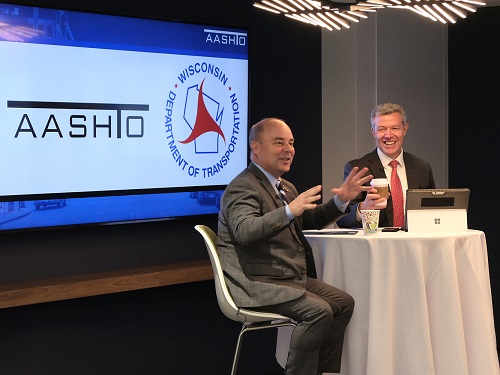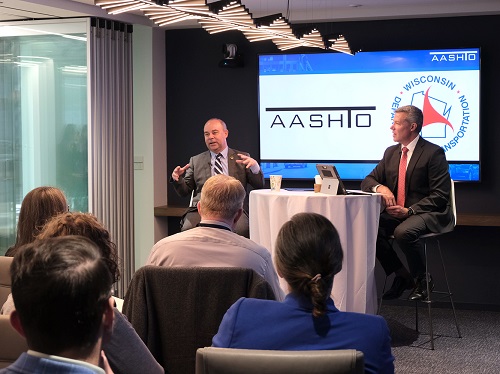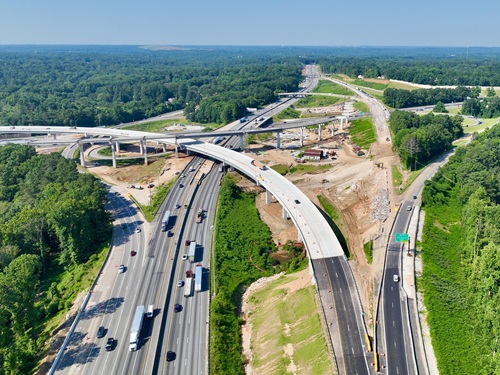Craig Thompson (above at left), secretary of the Wisconsin Department of Transportation and 2023-2024 president of the American Association of State Highway and Transportation Officials, talked about the importance of “togetherness” when tackling critical industry issues during a visit to the AASHTO office in Washington, D.C., on May 2.
[Above photo by AASHTO]
In town for the four-day AASHTO Executive Institute or AEI conference for state department of transportation executives, Thompson explained that “togetherness” among all of the industry’s stakeholders – state DOTs, contractors, local governments, chambers of commerce, and labor groups, just to name a few – is how beneficial mobility solutions can be forged despite often different policy positions and worldviews.

“While our governors may have polar-opposite points of view on many issues, we as state transportation executives and industry stakeholders can still come together and find areas of common ground on many issues,” he explained during his conversation with AASHTO staff.
“You really cannot do anything alone in this industry – you need all your transportation stakeholders and private sector partners,” Thompson said. “You are just not able to have an impact and move the needle on transportation projects and the benefits they bring if we don’t involve as many partners as we can.”
Since his appointment by Governor Tony Evers (D) in 2019, Thompson has overseen one of Wisconsin’s foremost and largest state agencies; managing an $8 billion biennial budget encompassing highways, roads, transit, railroads, airports and harbors.
He also credits his over 30 years of transportation leadership at the state and national levels, including a past presidency of the Mid-America Association of State Transportation Officials, for his emphasis on “togetherness” – a theme he also stressed in his presidential profile video, seen below.
Before he became Wisconsin DOT secretary, Thompson worked for the Wisconsin Counties Association for 16 years and then served as executive director of the Transportation Development Association for 12 years; an organization he described as a “group of groups” that worked to find common ground where transportation and economic development were concerned for the state.
“It’s about incorporating a broad view of the whole transportation system, bringing both the user and practitioner side together – trucking companies, chambers of commerce, local governments, harbors, airports, transit systems, contractors, labor groups, and others,” he said.

“We really tried to get out there why investing in transportation is good for the state and for the nation’s economy as a whole. Usually, we would vie against each other, but within TDA, we would leave that at the door because a rising tide lifts all boats,” he added.
Thompson also delved into his three major emphasis areas for his one-year term as AASHTO’s president: Bolstering safety on America’s roadways, realizing the promise of the historic Infrastructure Investment and Jobs Act or IIJA, and reinvigorating the transportation workforce.
“I really feel we need to sustain advocacy for investing in transportation and the economic competitiveness it brings,” he said. “I know we are struggling with high inflation and other issues as state DOTs but I feel strongly all arguments are irrelevant if we can’t show we have made lives better and safer, while increasing economic competitiveness, with the IIJA funding. We must make sure we are doing everything we can to get dollars out door and demonstrate the benefit from that investment.”
[Editor’s note: Thompson discussed those emphasis areas in greater detail during a panel discussion with fellow state DOT leaders from across the country at the at the 2024 Transportation Research Board Annual Meeting in Washington, D.C.]
One example of where the themes of “investment benefit” and “togetherness” can intersect occurred the day before Thompson visited AASHTO’s D.C. office, when Amtrak announced it would introduce expanded “Borealis” train service between St. Paul, MN, and Chicago via Milwaukee.
“This route includes eight stations in Wisconsin, and doubling the frequency of the service will better connect the many businesses, universities and tourist attractions along this corridor,” Thompson said.
“It was difficult to get three different governors, state transportation agencies, and Amtrak to come to an agreement, but I just feel this will be a very popular rail service; and if it is, we’ll build more,” he noted. “State DOTs are leading the way on passenger rail. And this agreement shows what we can do when we work together.”
 Top Stories
Top Stories
How Rising Construction Costs Could Impact Reauthorization
November 14, 2025 Top Stories
Top Stories

